kelefaba
Knight, Roderic. 1971. "Towards a Notation and Tablature for the Kora and Its Application to Other Instruments." African Music 5 (1): 23–26.
(Kelefaba)
p. 30
This kumbeno [sic] is for Kelefaba, supposedly the original kora tune, composed in honour of Kelefa Sane, a nineteenth century warrior in The Gambia.
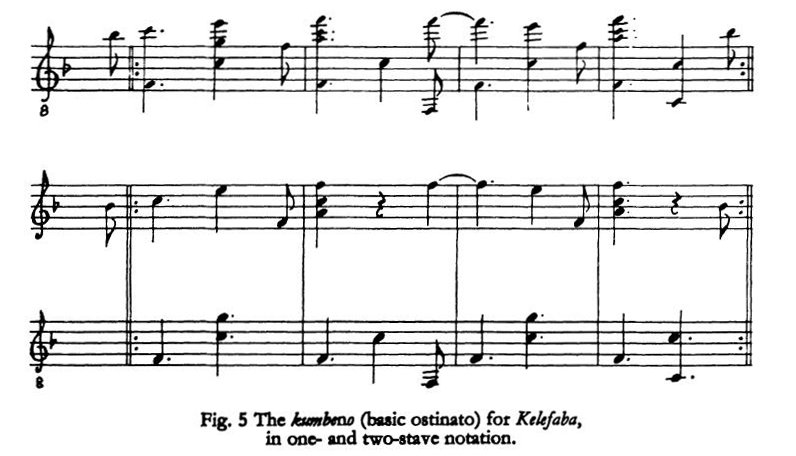
King, Anthony P. 1974. "Musical Tradition in Modern Africa." Journal of the Royal Society of Arts 123 (5221): 15-23.
(Kelefa Ba)
p. 18
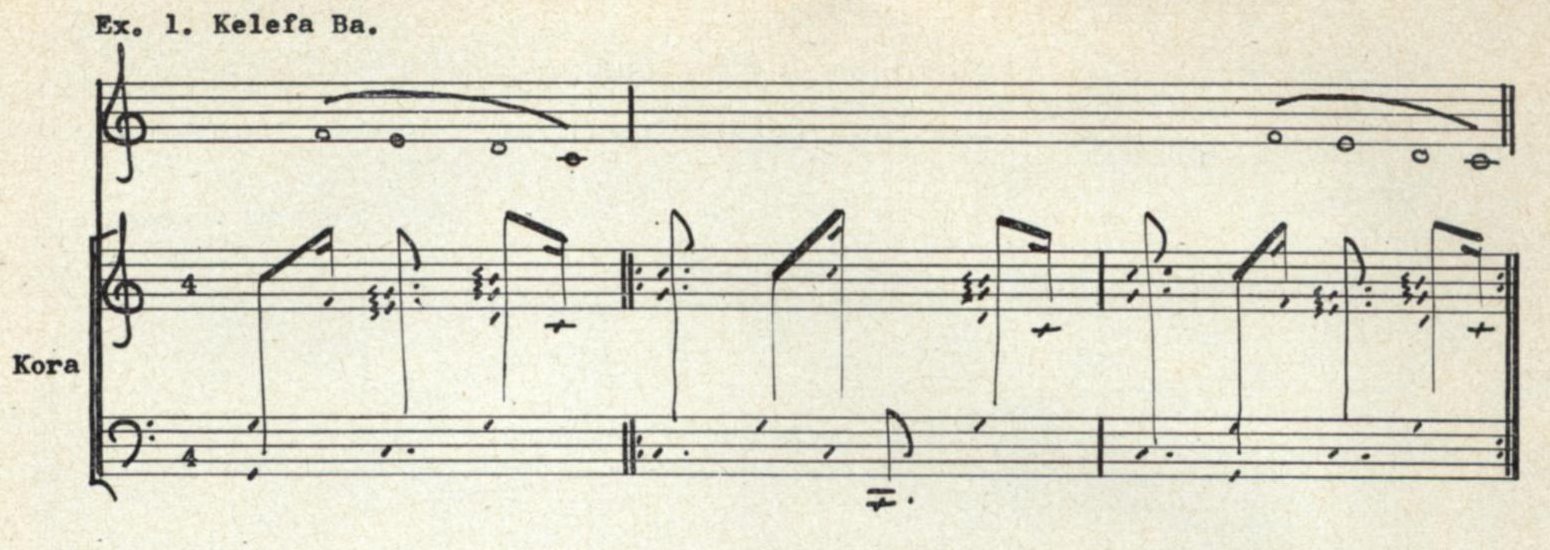
Charters, Samuel, prod. 1975a. African Journey: A Search for the Roots of the Blues. Vanguard, SRV 73014/5.
(Kelefa Ba)
"Kelefa Ba" is one of the best known kora songs, the song all beginners learn first, and it is in this tradition of narratives about great leaders.
Kelefa Sanneh was from the old Mandingo capital of Kabu, in what is now Guinea, and the song, said to be written by his own jali, Madi Wuleng, tells of his death in a battle on the north bank of the Gambia River in the mid-1800's. The song, like all jali narratives, tells only scattered parts of the story, but the piece is so familiar to its village audiences that the excitement is in the way new ideas are introduced or parts of the action described. Kelefa had come to Niumi at the request of the local king, Demba Sonko, who realized that Kelefa had little chance of surviving a battle where the enemy had been preparing for him and tried to send him away on an errand. Kelefa returned too soon, went into battle, and was killed.
The kora is in the most common tuning, known as Tomoraba. It is very similar to the European scale but the tempering differs in the third and seventh, which are lower than the European, and the second and sixth which are slightly higher.
Jobarteh, Amadu Bansang. 1978. Master of the Kora. Eavadisc, EDM 101.
(Kelefa Saane)
This is one of the best known and most frequently played of all kora pieces, and here it is an instrumental solo. Amadu bases his Kelefa on three themes, each one of which has a separate title and significance: Kelefa Saane, which is the first piece a kora student learns to play; Kuruntu Kelefa (introduced after four and a half minutes of this track), a processional piece, played when the musician walks behind his patron; and Jato (introduced after six minutes), which Amadu usually plays to accompany spoken recitation. All three are in Tomora Ba tuning.
Kelefa Saane is one of the most popular of the Mandinka heroes. He was a warrior prince (nyancho) from Badora in present-day Guinea-Bissau. When he was young he was sold into slavery for a misdemeanour and hence became known as 'the slave of the Maanes' (cf. the reference in A2), but later he was able to buy back his freedom. Like all true warior princes, he refused to live by anything but fighting, and soon set off for Niumi on the north bank of the Gambia river in order to assist King Demba Sonko in his war against Jokadu. After a number of adventures on the way, Kelefa eventually joined the King, for whom the war then took a favourable turn. Jokadu diviners, however, advised their people that Kelefa could only be killed by an albino with a silver bullet; Kelefa was then shot while lying under a tree.
This tune is said to have been composed by Koriyang Musa, who was personal musician to Kelefa. He was also the son of Jali Madi Wuleng, the 'inventor' of the kora. Kelefa Saane is supposedly the first piece ever composed specifically for the instrument.
Suso, Foday Musa. 1978. Kora Music from Gambia. Folkways, FW 8510. Reissued in 1990. Smithsonian Folkways, 08510.
(Kelefaba / Kuruntu Kelefa)
Tomoraba tuning.
These two pieces are often played together. They commemorate Kelefa Sanneh, a famous mercenary who fought in a 19th-century war between the kingdoms of Nyomi and Jokadu on the north bank of the Gambia River. "Kelefaba" is traditionally the first piece that the beginning Kora student learns. "Kuruntu Kelefa" ("Trailing Kelefa") describes the galloping of horses.
Kelefaba
| Mindolo banta, Kelefa la mindolo banta, | The millet beer is gone, Kelefa's millet beer is gone. |
| Kelefaba la mindolo banta | Great Kelefa's millet beer is gone. |
Kuruntu Kelefa
| Mansa jalo kuma fo baga le, Kari siya jama, a kela man siya (repeat) | The king's jali (says) Those who talk a lot are many, but thow who act are few. |
Knight, Roderic. 1982a. "Manding/Fula Relations as Reflected in the Manding Song Repertoire." African Music 6 (2): 37–47.
p. 39
Table One . . . includes the best known, most often heard, or otherwise significant songs in the [Gambian] repertoire. In each column the top few songs are the oldest, and the bottom few are the youngest. The majority in each case fall somewhere in between (often in the nineteenth century), but no chronological ordering beyond this is intended, since it is often not possible to date a song exactly. Most of the songs bear the name of their owner as the title. Where they do not, his name is shown in parentheses next to the title. The letter code at the right represents the person's "claim to fame" or calling in life, as shown in the bottom of the list.
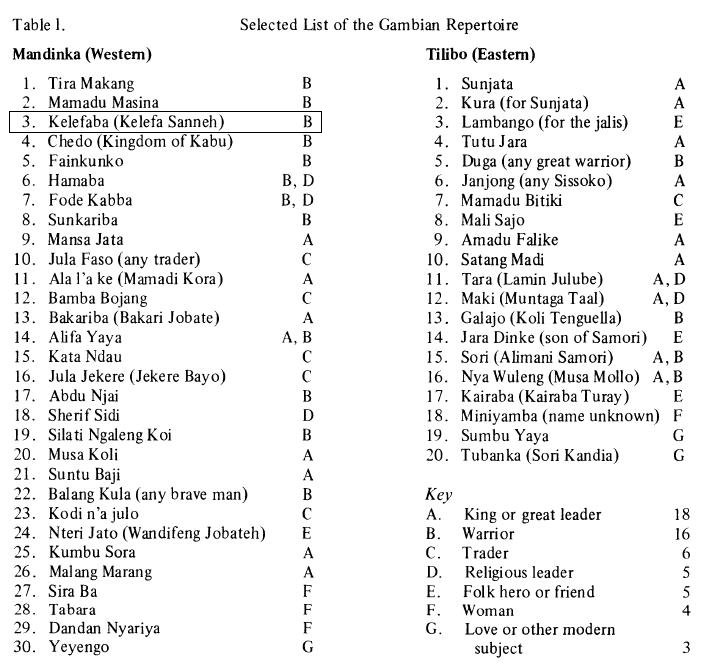
p. 40
Table Two shows the same fifty songs again, grouped this time by the ethnic background of the people commemorated.
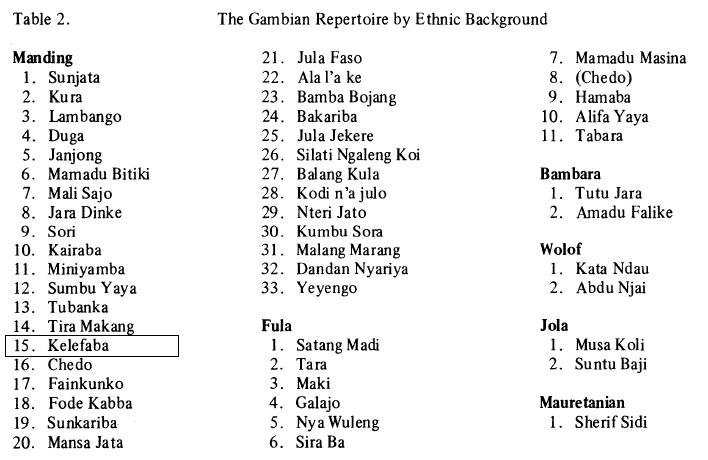
Knight, Roderic. 1982b. Review of Gordon Innes (1978). Ethnomusicology 26 (1): 168–70.
(Kelefa [Kelefa Saane, Kelefa Baa, Kuruntu Kelefa])
p. 169
On one particularly puzzling feature of the Kelefa story Innes notes that Kelefa is referred to as "Jola Kelefa," implying that his ethnic lineage is Jola rather than Mandinka. He reasons that the surname Saane, recognized by all as Mandinka, may have once been a Jola name, assimilated by the Mandinka when they came to the area. When I enquired about this same point in 1970, one of the jalolu with whom I was studying explained that jola in Mandinka means "payer"—one who pays, or in this case, repays. Thus Jola Kelefa may be interpreted to mean "Kelefa the Avenger."
Duran states that "there is some evidence from the oral tradition that Kelefa [Baa] was the first piece composed for the kora" (p. 17). This is often heard, but it must be discounted, since Kelefa lived in the mid-19th century and the kora was well enough known to be described (18 strings) and named (korro) already in the 18th century by Mungo Park (1969: 213). It is quite true that in western Gambia, Kelefa Baa is the first piece played by beginning students, and it is quite possible that it was known before Kelefa's time under another name.
Jessup, Lynne. 1983. The Mandinka Balafon: An Introduction with Notation for Teaching. La Mesa, Calif.: Xylo.
(Kelefaba / Kuruntu Kelefa)
p. 32
"Faringbulo" was the first piece of music that nine of the jalis [of the twenty interviewed] learned to play, "Lambango" was the first tune for four others. "Kelefaba" and "Jakaa" were learned first by two other jalis. In addition, ten of the jalis said they learned to play songs in a set order. Yet no two jalis listed the songs in the same order.
pp. 146–59 (Appendix 2: Balafon Repertoire)
| Title | Kelefaba |
| Translation: | Great Kelefa |
| Dedication: | Kelefa Sanneh |
| Notes: | commemorates Kelefa's death |
| Calling in Life: | Warrior |
| Original Instrument: | Kora |
| Region of Origin: | Manding (Western Coastal Region) |
| Date of Origin: | M (19th & 20th c. up to WWII) |
| Sources: | 3 (R. Knight 1973) |
| Title | Kuruntu Kelefa |
| Translation: | Trailing Kelefa |
| Dedication: | Kelefa Sanneh |
| Notes: | sung to Kelefa when he was travelling |
| Calling in Life: | Warrior |
| Original Instrument: | Kora |
| Region of Origin: | Manding (Western Coastal Region) |
| Date of Origin: | M (19th & 20th c. up to WWII) |
| Sources: | 3 (R. Knight 1973) |
Knight, Roderic. 1984. "The Style of Mandinka Music: A Study in Extracting Theory from Practice." In Selected Reports in Ethnomusicology, vol. 5, Studies in African Music, ed. J. H. Kwabena Nketia and Jacqueline Cogdell Djedje, 3–66. Los Angeles: Program in Ethnomusicology, Department of Music, University of California.
(Kelefaba / Kuruntu Kelefa)
p. 8
The opening line of "Kelefaba", a song for Kelefa Sanneh, a mercenary who fought in the nineeeth-century battle between the kingdoms of Nyomi and Jokadu on the north bank of the Gambia River commemorates Kelefa's death: "Kelefa the Avenger; Kelefa the Great of Bador has died; his spear is lying at Bariya." In "Kuruntu Kelefa" (Trailing Kelefa), a song that was sung for him while he was traveling, another death is commemorated: "Saliya, where is Saliya? Friend of the jalolu, Saliya the merchant has lain down."
p. 10
Some of the older kora players can still demonstrate how they used to play "Kuruntu Kelefa", imitating the howl of a hyena with a (rare) stepwise ascending passage on the kora, or the sound of gunfire by repeated heavy plucks of the lowest string on the instrument.
p. 12
Example 1. A donkilo line from "Kelefaba"15

Example 2. A donkilo line from "Kuruntu Kelefa."

15. "Kelefaba" and "Kuruntu Kelefa" (Ex.2) are included on several recordings, OCR 70, A-3 being one of them.
p. 16
The donkilo melodies for "Kelefaba" and "Kuruntu Kelefa" (Examples 1 and 2) illustrate the principal Tomoraba mode. In notation this tuning is indistinguishable from Hardino.
pp. 19–20
Melodically we may discern three types of kumbengo, based on their relationship to the donkilo.
Type II: Derivative. . . . A derivative kumbengo (and the derivation may work both ways) is related to the donkilo line but played very idiomatically on the instrument. This type of kumbengo is very common and takes many forms. At the very least, playing idiomatically involves two parts—the melody, and a bass line. The melody may be only a fragment of the donkilo, as in the kumbengo for "Kelefaba." The opening four notes of the donkolo are provided with a bass line and this short ostinato is then played six times (actually in three slightly varied pairs) as the full donkilo melody unfolds.
Example 11. "Kelefaba," kumbengo and donkilo, showing the relationship between the two.

p. 21
The method of adding a bass line to a fragment of donkilo to form an ostinato may be used for extended passages as well. A well-known passage that may be incorporated into severla differnt songs combines a long vocal melody with a rapid "timbango and its answer" figure. A transcription of it as performed near the end of "Kuruntu kelefa" on the Ocora disc mentioned earlier is shown in Ex. 13. It is called "Kele Borila" ("War Coward"). The words are as follows:
The one who runs from war can't say what happened there.
War will come, you should be alert.
Plans will be made, you should be alert.
Let's be quick, let's be quick.
Oh in our father's time we were quick.
Look, the marabout (Muslim holy man) is falling upon us.
Example 13. "Kele Borila," a vocal line played over a steady "timbango and its answerer." (Heard on OCR 70, A-3, at 8'15".)
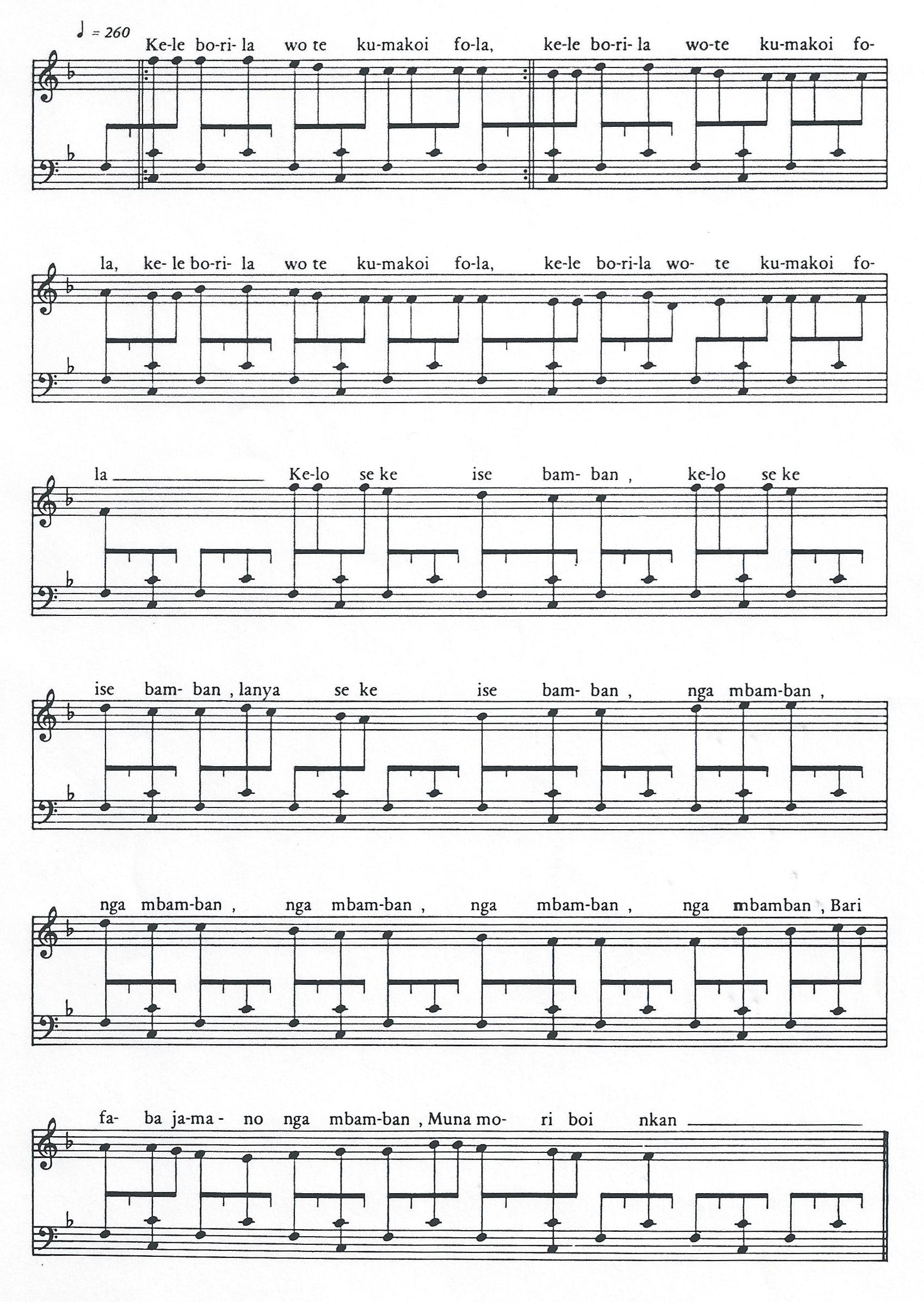
pp. 25, 27
There are four standard konkondiro patterns.
IV: "Kelefa." The fourth konkondiro, dubbed the Kelefa konkondiro for its familiar association with the two songs for Kelefa Sanneh, displays the same general character as the Bakariba konkondiro, but spans 16 pulses instead of 12.
x · · x · · x · · · x · x · · ·
pp. 51–59
In this final example of sataro singing, we shall look at a 2.7-minute block of three uninterrupted sataro passages drawn from a nine-an-a-half-minute performance that includes both "Kuruntu Kelefa" and "Kelefaba" alternately. It is performed by Nyama Suso, a leading Gambian kora player.
(See Knight [1984].) (Transcriptions, Analysis, and Discussion.)
Jatta, Sidia. 1985. "Born Musicians: Traditional Music from The Gambia." In Repercussions: A Celebration of African-American Music, ed. Geoffrey Haydon and Dennis Marks, 14–29.
(Kelefaa / Saane)
p. 23
Not all the pieces in the repertoire bear personal names as their titles, but most of them are named after the personalities for whom they were originally composed. Some examples of these are: FodeKabaa, Kelefaa, Saane, Saamoori, Alfaa Yaayaa, Mammadu Maasina, Satan Madi, Sirifu Siidi and Jula Jekere, all of which bear the names of historic figures.
Sadji, Abdoulaye. 1985. Ce que dit la musiqe Africaine.... Paris: Présence Africaine.
(Kélé-Phaba)
pp. 69–74
Kélé-Phaba était de Baria, dans le pays manding.
Haï de ses frères consanguins qui étaient nombreux, il leur dit un jour :
— Je deviendrai maître de Baria.
Cette parole fut répétée de bouche à oreille avec une nuance de scepticisme* et fit quinze fois le tour de la contrée. Tout le monde pensa :
— Il est vraiment fou, s'il a une telle prétention. Est-il Dieu ou son prophète ?
Un jour, toutes les femmes du village étant rassemblées pour puiser de l'eau, Kélé-Phaba survint, maltraita et tua plusieurs d'entre elles. Il était monté sur son cheval, Alabédiong-Sola.
Tous les hommes du village sortirent ensemble pour se venger de lui. Il se battit seul contre eux, car ni la balle du fusil, ni la flèche, ni le poignard ne pouvaient traverser sa peau. Il mit les uns en déroute, en tua le plus grand nombre et fit garrotter* les autres. Et on lui disait :
— Pourquoi n'as-tu pas demandé le trône de ton pays, au lieu de maltraiter les sujets de Baria ?
Un autre jour, comme il causait avec les grands du village, on l'apostropha, disant :
— Et d'ailleurs, Kélé-Phaba, tu n'es pas le plus brave de la terre !
Il se leva et dit :
— Je suis le plus brave des rois !
Comme on lui répondit: « non », il demanda: « pourquoi ? » Alors un grand du village se leva et dit :
— Kélé-Phaba, il y a un serpent dans l'eau de notre rivière. Il quitte sa demeure une fois par jour pour respirer l'air et s'étendre au soleil.
Kélé-Phaba tressaillit :
— Est-ce possible?
Mais le grand continua :
— Depuis dix ans, il fait chaque année plusieurs victimes, et tous ceux qui régnèrent avant toi ont fui devant lui. Aussi Baria ne peut-il compter aucun brave. Je le jure, Kélé-Phaba, nul ne pourra nous convaincre, tant que le serpent demeurera dans la rivière et mangera nos petits-fils et nos fils. Si tu es vraiment brave, débarrassenous de ce serpent.
Et Kélé-Phaba, se levant, dit :
— Demain, je le ferai sortir de la rivière et je le tuerai. Soundiata n'avait-il pas dit: « Demain je ferai tomber le baobab de Tam-Diara-Fodé?» Il avait dit: « Allons-y tout de suite, que je le fasse tomber devant vous. »
Le lendemain, au Yor-Yor, Kélé-Phaba chemina vers la rivière, accompagné de tous les grands du pays. Puis ayant fait sortir le serpent, il le tua.
Ensuite, il convoqua le peuple et lui montra les restes de l'animal. Tout le monde se mit aussitôt d'accord pour reconnaître Kélé-Phaba roi de Baria.
Il aimait à parler de sa bravoure et de sa puissance. Au milieu des grandes assemblées, il se levait et disait:
— Moi, Kélé-Phaba, je l'affirme, nul ne saurait supporter mon regard, car il est mortel.
Puis il dit : « Je suis le plus puissant des hommes. » On lui demanda: « Pourquoi ? »
— Parce que j'ai tué le serpent que personne, avant moi, n'avait osé braver.
Il ne se doutait pas qu'avant lui, Soundiata avait vaincu le diable, fait tomber le baobab symbolique de TamDiara-Fodé, que Samory avait soumis un peuple de chiens, résisté aux Oreilles Rouges pendant vingt ans et remporté une victoire sur les Vali-You, hommes sages qui ont la grâce et la bénédiction de Dieu. Il ne se doutait pas qu'avant lui, Kombo-Sylla avait blessé Dieu et fait couler son sang et son pus, créé sur la terre un paradis et un enfer à l'image de l'enfer et du paradis bibliques. Il ne se doutait pas, qu'avant lui, Samba Galadiégui avait tué le diable, maître des forêts denses, après l'avoir employé à servir sa puissance.
Peu de temps s'écoula ensuite, et Mansa-Demba, roi de Niomé, vint attaquer Kélé-Phaba. Kélé-Phaba le vainquit, le fit garrotter, puis il le moula dans la terre grasse et fit de lui une statue. Ensuite il visita le Tiokadou et dit aux habitants de la contrée :
— Aujourd'hui je vous ferai voir quelque chose que vos yeux d'homme n'ont jamais vu.
— Lorsque j'arrive dans un pays, je suis son hôte jusqu'au milieu du jour... et l'après-midi, je deviens son roi.
Ayant dit, il réclama la couronne et annexa tout : hommes, femmes, vieillards et enfants, et jusqu'à la bouse des troupeaux. Il revint alors à Baria et interrogea le peuple :
— Que dites-vous encore ?
Tout Baria, une fois de plus, se prononça en sa faveur. Puis comme il sentait sa fin venir, il dit :
— Un vendredi va venir, et le vendredi suivant je ne serai plus de ce monde.
Lorsqu'il mourut, le village entier refusa de l'enterrer. Car Kélé-Phaba n'avait régné sur tous que par la force. L'on n'attendait que sa mort pour le méconnaître et le couvrir d'ignominie. Les grands du pays dirent :
— Qu'on le jette hors du village et qu'on l'expose à la rapacité des vers, des hyènes et des vautours.
On jeta Kélé-Phaba hors du village et on exposa son cadavre à l'appétit sordide des bêtes qui se nourrissent de pourritures immondes. Les hyènes s'assemblèrent pour dévorer ce cadavre, mais la reine des hyènes dit :
— Ne mangeons pas la chair de Kélé-Phaba, il fut grand parmi les grands de Baria et nous devons respecter son corps.
Puis ce fut le tour des vautours majestueux, ex-rois déchus. Mais le roi des vautours parla à son peuple :
C'est le corps de Kélé-Phaba, ne le mangeons pas. Car il a une tête supérieure à la nôtre et sa science fut vaste.
Les vers, à leur tour, convives innombrables, marchèrent en colonnes serrées vers le cadavre maudit. Mais les vers eux-mêmes respectèrent le cadavre de Kélé-Phaba.
Sa tête pourrit, se dépouilla de la peau et des cheveux. Pour l'humilier jusque après sa mort, ses frères consanguins prirent le crâne blanc et l'exposèrent à l'entrée de leur demeure.
Mais on s'aperçut que tout homme qui passait sous le crâne mourait le lendemain.
C'est ainsi que Kélé-Phaba se vengea du peuple ingrat de Baria, dont il fut le premier vrai brave et à qui il donna la gloire et le respect des autres nations.
C'est pourquoi l'on dit: « Kélé-Phaba mourut, mais sa tête se bat encore. »
* Scepticisme : doute.
* Garrotter : lier solidement.
Jobarteh, Amadu Bansang. 1993. Tabara. Music of the World, CDT 129.
(Kelefaba)
One of the oldest pieces associated with the kora, Kelefaba commemorates the death of Kelefa Saane, a great warrior prince. In this song, Amadu uses classic lines which announce the great prince's death, and sings his praises in a style common to all West African griots. Among the Mandinka, Kelefaba is often referred to as the "ABC" of kora since it contains so many of the basic elements of kora playing. It is one of the most important pieces in the entire Mandinka repertoire, and is played in tomoraba tuning.
Suso, Salieu. 1993. Griot. Lyrichord, LYRCD 7418.
(Kuruntu Kallafa)
Kallafa was a Mandinka warrior king who fought many great battles against the Fulani, another West African people. After one such battle, Kallafa found himself with a great number of Fulani prisoners reluctant to return with him to his kindom. He tied them together, and he and his Mandinka warriors literally pulled them there. As they approached, the people of his kingdom saw in the distance the great cloud of dust raised by his warriors and their prisoners. Not knowing the cause, the people imagined that it was perhaps the smoke of the great fire. When Kallafa was close enough to be seen, the Griot sand this song, Kuruntu Kallafa, which means Kallafa Pulling, as he entered his kingdom.
Kouyate, M'Bady, and Diaryatou Kouyate. 1996. Guinée: Kora et chant du N'Gabu, Vol 1. Buda, 92692-2.
(Kele faba)
Kelefa: war leader—Ba: great.
"The millet wine calabash is empty. Kelefa Ba will fly into a rage". Kelefa Sane was a great Diola king from N'Gabu. During expeditions, he would go into terrible tantrums whenever millet wine went missing.
Suso, Jali Nyama. 1996. Gambie: L'art de la kora. Reissue of 1972 with other unreleased material. OCORA, C 580027.
(Kuruntu Kelefa and Kelefabaa)
This pair of songs is dedicated o Kelefa Sanneh, legendary hero of the Mandinka people. Sanneh was a mercenary from Kaabu. In the nineteenth century, Demba Sonko, King of Niumi, on the north bank of the Gambia River, requested his aid in the battle with neighboring Jokadu. Sanneh came and fought gallantly for several days, but the people of Jokadu, using local medicines and trickery, succeeded in bringing him down. As he lay dying, he asked that he be buried under a mahogany tree, saying "Regardless of where the mahogany grows, its bark is bitter". To him it was symbolic of his resolve in battle. [See Gordon Innes, 1978, for a detailed literary study of this song.]
"Kuruntu Kelefa" or "Trailing Kelefa" was played during Sanneh’s lifetime when he traveled from place to place. "Kelefabaa" ("Kelefa the Great") commemorates his death. Both were composed by Jali Madi Wuleng, Sanneh's personal jali. "Kelefabaa" is typically taught to beginning kora students. It is played in tomorabaa tuning.
In this performance Suso alternates between the two songs. Some of the lines he sings are excerpted below. They show the typical content of jaliyaa, providing glimpses of the events, people, and places associated with the person named in the song, plus a mixture of proverbs, religion, and philosophy.
Kuruntu Kelefa (after a brief introduction): "Saliya Ndambungo, friend of the jalolu, benevolent merchant / Saliya has died / Ah, Kelefa ran his horse through the forest / He was the lion of the forest!"
· Kelefabaa (at 2'00): "Kelefa the Avenger from Badora has lain down / His spear is at Bariya / His millet beer is gone / Hunger did not kill him, nor did threadbare clothes or woman-troubles / Ah, life! No matter how you believe in God, life will betray you one day / All things standing will one day lie down".
· Kuruntu Kelefa (at 3'55): "There are many big talkers, but few who put words into action / Their times are gone / The best nyancholu (warriors) were from Balaba Tinkida, Balaba Kansuma, Bonjo Suma / Their names were Sanneh and Manneh, and their cousins the koringolu were Sonko and Sanyang / In praising the koringolu, we say, 'The water from Palm Tree Well is bitter, but the water-bearers are beautiful!' / Kelefa Sanneh, warrior of Kaabu / He died in the time of Kind Demba Sonko, the tax-collecting king / King Demba’s times are gone, but the Sonkos live on // A soldier who flees from battle can’t say what happened there / Ah, in Kelefa's time, the battle cry was 'Let's hurry to prepare or we’ll be overrun by the Muslim vanguard!'"
· Kelefaba (at 8’45): "I am following my father’s footsteps, doing jaliyaa for you / You too must follow your tradition and support the work of the jali! / Ah, see the horses dancing / Look, the war is over, the horses are dancing".
Suso, Foday Musa, and Bill Laswell. 1997. Jali Kunda: Griots of West Africa and Beyond. Ellipsis Arts, CD3511.
(Kelefa)
p. 52
"Kelefa" is the song that you should start with on the kora—it's like the alphabet. It was the first song that my ancestor Jalimadi Wulen Suso made up for the kora. Later, it became the tradition to learn it first.
Charry, Eric. 2000. Mande Music: Traditional and Modern Music of the Maninka and Mandinka of Western Africa. Chicago; London: University of Chicago Press.
(Kelefaba / Kuruntu Kelefa)
p. 12
The pieces jelis play are all named. Most often the name is that of the person to whom the piece is dedicated, such as Kelefa or Sunjata.
p. 118
One of the published recordings of the kora, if not the first, was made by Laura Boulton (1957-disc) in the early 1930s. The two kora pieces, Kelefaba and Amadou Masina, are still played the same way today.
p. 119
Stories of the origin of the kora center on Jali Madi Wuleng, who is widely believed to have first discovered (Md: bondi, "caused it to come out") the kora with the aid of a jinn during the era of the Kabu empire.51The question of when Jali Madi Wuleng lived is linked with that of when a warrior named Kelefa Sane lived and is a subject of controversy among jalis. Kelefa's brave exploits have been canonized in Kuruntu Kelefa (Following Kelefa), associated with his lifetime, and Kelefaba (Great Kelefa), associated with his death. These two pieces are believed to be the earliest ones composed on the kora, associated with its very origins, and 1 have often heard them referred to as the ABC of the kora. Simplified versions of the pieces are the first items that beginning kora players from The Gambia and Casamance learn, and many pieces derived from them have entered the kora repertory. No other kora pieces are believed to predate them, nor is the kora associated with the repertories of thirteenth-century Mali or eighteenth-century Segu or Kaarta.
Some believe Jali Madi Wuleng was Kelefa Sane's jali and presumably the composer of Kuruntu Kelefa (e.g., Bamba Suso, Amadu Bansang Jobarteh, and Knight, in Jali Nyama Suso 1996-disc: 19). The era they lived in can vary widely according to who is speaking.
51. Sources used in this section are Bamba Suso (l969?-disc; in Innes 1974:40–41; 1978: 34–35, 62–67), Sidiki Diabate (l988-disc; 1990-per: 171–73, 427–32), Amadu Bansang Jobarteh (l990-per:A3-23), and Mbady Kouyate (and Diaryatou Kouyate 1996-disc:8). Sanimentereng (Sanémentin) is sometimes cited as the specific place of origin of the kora (Bamba Suso, Mbady Kouyate).
p. 148
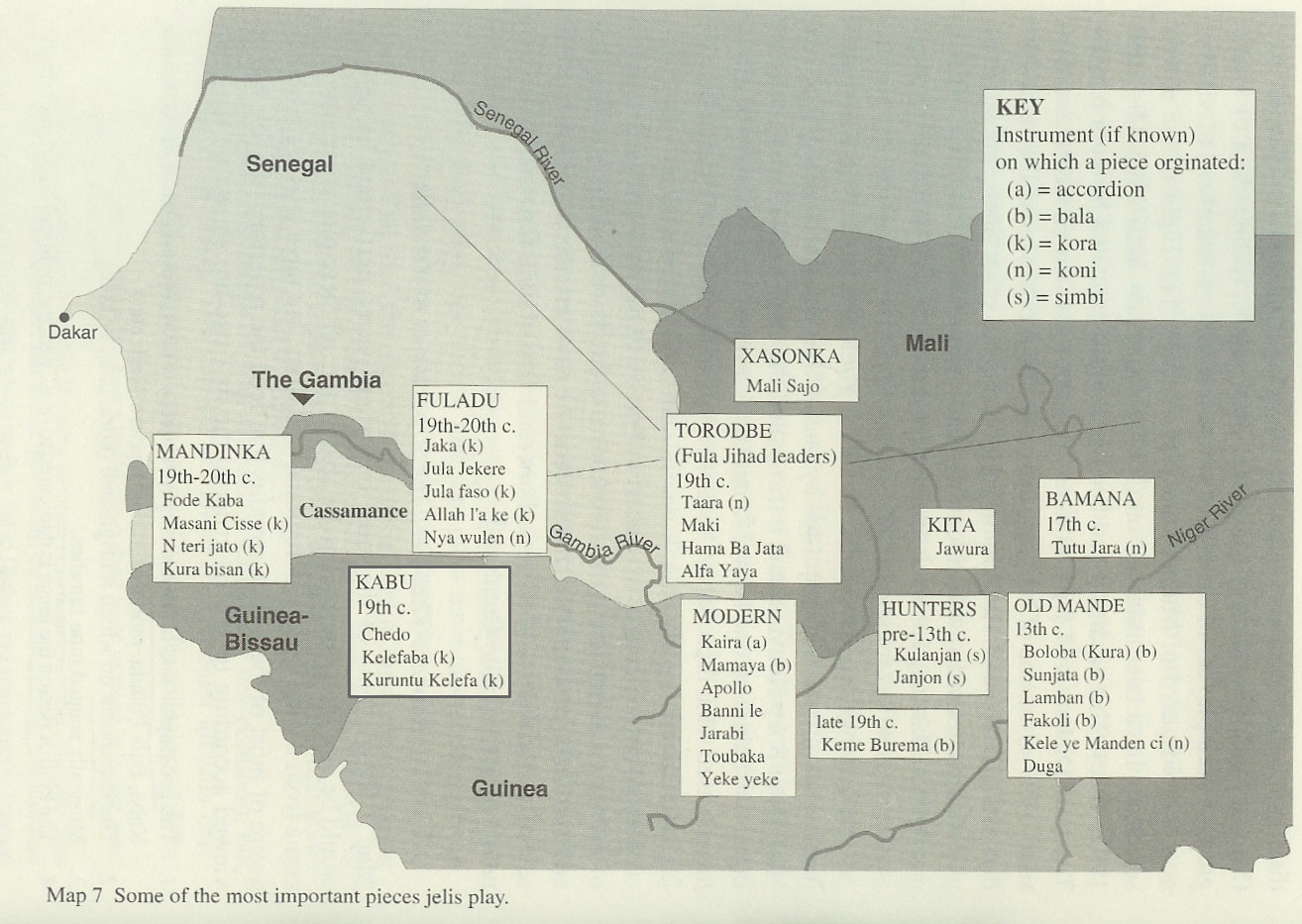
p. 149
Although a significant body of pieces is intimately wrapped up in each instrument, some pieces transcend geographical borders and are known far and wide. A kora player from Mali, for example, may know Senegambian kora pieces even though they are of little interest to his Malian patrons. Such is the case with the kora player recorded by Laura Boulton (1957-disc) in Bamako in the early 1930s, who played the piece Kelefaba, celebrating a warrior (Kelefa) from the westernmost Mande region (Kabu) who had no influence on the Mali empire in general and was a Jola (neighbors of the western Mandinka). Politically, Kelefaba is not important outside the Senegambia region, but it is known to kora players all over because of its status as a prototypical kora piece, it is like an ocean that all can drink from, as Sidiki Diabate described it (see below).
p. 150
Bala Dounbouya, who grew up in the region of Siguiri (Guinea), spent much of his life in Bamako (Mali), and then moved to Senegal, plays some of the more prominent pieces from The Gambia and Casamance, such as Masani Cisse and Kelefaba (as well as the Senegalese national anthem). He prefers pieces from his native Guinea, but many of them are virtually unknown in Dakar where he lives and teaches. Conversely, many of the Senegambian pieces he plays are insignificant in Guinea.
p. 151
The pieces Sunjata, Lamban, and Boloba all have a similar harmonic progression (transcription 13), yet they differ enough in their realizations so that they are not spoken of as being musically related. A Kelefa complex, on the other hand, is recognized as a group of related pieces, most likely because of the idiomatic way of playing pieces that belong to it.
p. 155
As noted above, Kuruntu Kelefa and Kelefaba are widely believed to be the source of kora music.
That is why any jali who is playing Kuruntu Kelefa, if it pleases them, with Allah's aid, they can create something from it and offer it to their patron. Kuruntu Kelefa is a great ocean. Everyone drinks from it. . . . It [Kelefa] is like the alphabet. Much has come from it." (Sidiki Diabate 1990-per, 3, 61)
p. 159
The origins of the various kora tunings are not clear, but the regional associations of pieces played in each tuning may provide clues. Mandinka kora players from the kora heartland (The Gambia, Casamance, and Guinea Bissau) generally agree that Tomoraba (big, great Tomora), also called Silaba (main way, main road), is the original kora tuning and that the oldest kora pieces (e.g., Kuruntu Kelefa and Kelefaba) are played in that tuning (Jobarteh 1990-per:A190, 534; King 1972:126–33;Knight 1991a:19).
pp. 170, 179–82
(See Charry, 2000.) (Kora transcriptions: Kuruntu Kelefa, N'teri jato, and related pieces.)
p. 249
. . . Kelefaba, one of the oldest pieces that is believed to have originated on the kora
p. 323
"Yes, it is the alphabet [of the kora]. If someone wants to learn the kora, if you want to learn the kora, if someone wants to teach you the kora, he should play Kelefaba for you. It is the alphabet because it has the kumbengo of every piece in it." (S. Diabate 1990-pèr:445)
pp. 398–401 (Appendix C: Recordings of Traditional and Modern Pieces in Mande Repertories)
Kora: Kuruntu Kelefa/Kelefaba
Jali Nyama Suso ([1972] 1996) Gambie: L'art de la kora
M’Bady Kouyate (1996, vol. 1) Guinée: Kora et chant du N'Gabu
Seck and Diabate (1977) Africainement votre. . . . Deux authentiques griots Africaines: Mamadou Seck et Boubacar Diabate
Sissoko, Djelimoussa "Ballake." 2000. Deli. Indigo, 2576.
(Kouroutoukéléfa)
Mélodie guerrière qui accompagnait les conquêtes du roi.
Knight, Roderic, dir. 2005. Mande Music and Dance: Performed by Mandinka Musicians of The Gambia in the Late Twentieth Century. Lyrichord Discs, LYRDV-2001.
(Kelefabaa)
pp. 17–18
The song is "Kelefabaa," a staple of the kora repertoire, performed by Alaji Jobarteh. Selections of the text are included below. The rapid narrative lines in sataro style have been omitted:
| Moriba Janneh, . . . | (a person's name) |
| Jola Kelefa, Badora jola ye, sansango da la jola y'e la. | Kelefa the Avenger from Badora, eh; The avenger from the bamboo stockade has died. |
| Duniya, Jola be laring Bariya, Mariama Nanki la Kelefa Sanneh balanna. | Ah world, he is lying at Bariya, Mariama Nanki's Kelefa Sanneh, the "no-sayer." |
| Malu man diya foroya; Yara, ning foro maluta, a nyanta fala le. | Shame is not good for noble people; You know, if a noble is shamed, he would rather die. |
| M be ke n fa ti, jalolu b'e ke fa ti, Jali n'a jiati m be ke n fa ti. | I'm following my father's footsteps, all jalis do this; Jali and patron, we do as our fathers did. |
| Lamin janjungo diyata Musu Kebba Sarr, Jammai Sarr, Koringo Sarr. | The times in Lamin (town) were good for Musu Kebba Sarr, Jammai Sarr, and Koringo Sarr. |
| Marolu ban ne, kelo ye marol' ban ne, Damang kelo ye marolu ban ne. | The warriors are gone now, the war chiefs are gone, War among them has finished them off. |
see also:
Camara, Sirifo. 2010. The Epic of Kelefaa Saane. Trans. Sana Camara. Bloomington: Indiana University Press.
Durán, Lucy. 1978. "The Music." In Kelefa Saane: His Career Recounted by Two Mandinka Bards, ed. and trans. Gordon Innes, 16–26. London: SOAS.
Innes, Gordon. 1976. Kaabu and Fuladu: Historical Narratives of the Gambian Mandinka. London: University of London School of Oriental and African Studies.
———. 1978. Kelefa Saane: His Career Recounted by Two Mandinka Bards. London: SOAS.
Wright, Donald R. 1987. "The Epic of Kelefa Saane as a Guide to the Nature of Precolonial Senegambian Society-and Vice Versa." History in Africa, vol. 14, pp. 287–309.